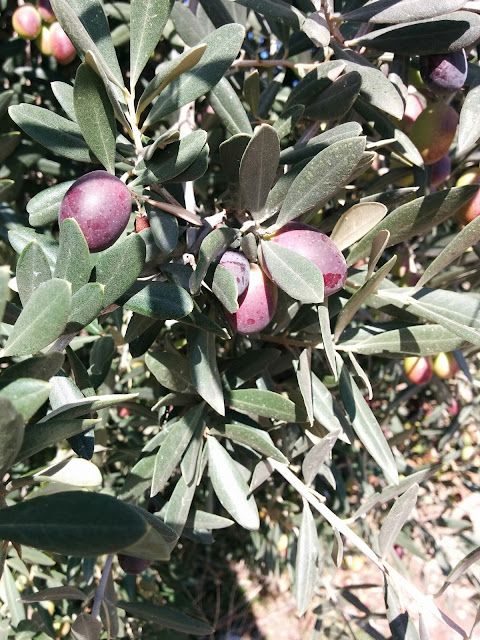| Credit: Europehaven.com |
This morning we drove from Granada to Cordoba, our next destination in this trip. But it's less than three hours if you go direct, so why go direct? We started for Cordoba going the opposite way from Cordoba. {J says-We just love a road trip.}
The Sierra Nevada is a mountain range just north of Granada. They are the tallest mountains in Spain, rising 3400 meters (over 10,000 feet), and usually capped with snow. The hills of Granada could be called foothills of the Sierra, and we could see the high peaks from our neighborhood of Albaycin. What could be better than a drive up to the ski resort in the Sierra Nevada National Park?
 |
| Of course we had to stop for pictures |
 |
| Such a dry landscape! Such lovely sun! |
 |
| Spines and needles on most plants. |
 |
| The rock is so friable it erodes into spikes and spires |
We were so interested in the geology, the cracked and shattered hills and gravelly scree. It seemed to be limestone and sandstone in layers, and what we read later agreed. We couldn't really find any descriptions of the rock that were satisfying - either somebody's dissertation overwhelming with detail on a small point, or tourist brochure type descriptions of the "look at the rocks" variety. We had fun poking around in google, though, and picked up a few things, for instance a basement layer that goes back perhaps as far as the Pre-Cambrian.
There wasn't any snow where we were. We stopped for a snack at the ski resort town of Sierra Nevada, which was full of delivery trucks and apparently empty hotels and condos. We could see the lifts and so forth - but not a flake of white stuff. People seemed to be getting ready for hordes to come later. We had read that November is the wettest month in Granada, but we certainly haven't seen even a hint of a cloud. It's an unusually dry year, still hope springs eternal.
 |
| No menu del dia today |
We drove from the Sierra Nevada National Park straight to Cordoba, stopping only for lunch.
Southern Spain is olive country. Olive trees as far as the eye can see. This picture shows a processing plant with huge silo-looking vats (doubtless for oil), trees close, trees far, trees beyond the reach of vision.

Andalusia, this region, is the world's largest producer of olive oil. We could well believe it!
Julianne reports that during the Roman Empire, 85% of olive oil imported to ancient Rome came from the drainage of the Guadalquivir River. The Guadalquivir starts well north, passes through Cordoba, through Seville, and down a few hundred miles to the sea just north of Cadiz.
We knew this when we were in Rome. Testaccio mountain, a huge hill composed of broken pottery from olive oil jars from Spain, was just across the river from our apartment. It must have been a smelly mess then, but today it's a tourist draw.
So this has been olive country for a very, very long time. And they seem to have the production process down. Fields of old trees, of mature but younger trees, of baby trees. All the ground plowed so no other living thing gets any water that could go to the olives. Processing plants dotted all around.
The picking hasn't started in earnest. We saw occasional teams, tarps spread under the trees, with long poles beating the high branches, or in one case vibrating them somehow. Julianne said that to pick all this many olives that way, they must hire every single able-bodied man in southern Spain and northern Morocco too. Our friend Janet picks her own olives by hand, and we were so impressed - it's actually hard work.
We finally made it to Cordoba. Our hotel is right in the heart of the old city, just near the Guadalquivir River and only a couple blocks from the sights we came to see. Such narrow one-way streets! I don't have a good picture of the narrowness, because I was totally focused on not scraping the sides of the car on the stone walls. At one point we had to pull in the side-mirrors to make it through. And then when the road widened, it was blocked a different way.
 |
| Nothing to do but relax and go real slow. |
We struggled through, of course, and just next to our hotel, in a little hole-in-the-wall place, got our reward: pomegranate and orange smoothies. Life is looking up, here in Cordoba.
  |
| Nancy's reward for really hard driving. |
by Nancy, with a couple pictures from Julianne



I think the things you covered through the post are quiet impressive, good job and great efforts. I found it very interesting and enjoyed reading all of it...keep it up, lovely job.. formentera day trips
ReplyDeleteExplanation, this exegesis is a clean culmination which often typically is aware of this activate's episode of a situation location. Think of your document in an didactic placing is actually known because "official book" is usually soporific by disciples, academy trees, flicker analysts to do the tasks. vacation rental Arizona
ReplyDelete